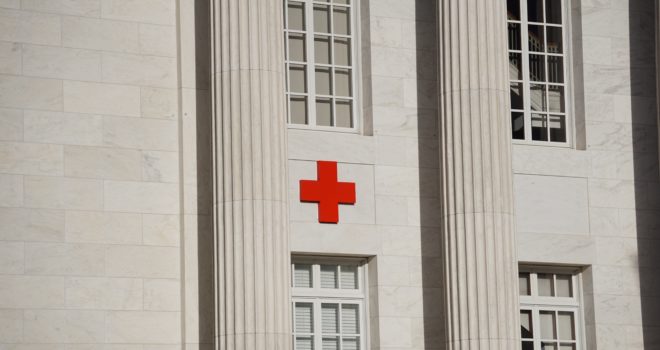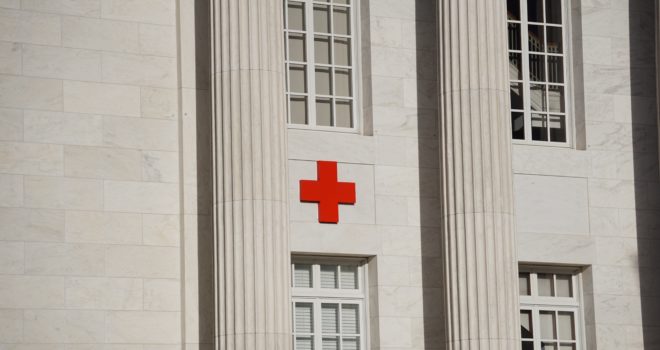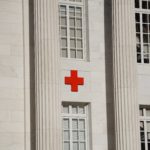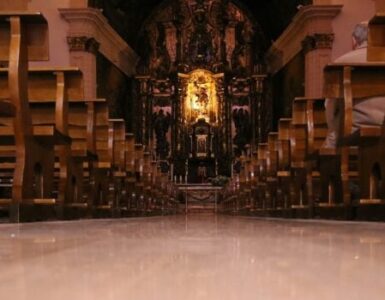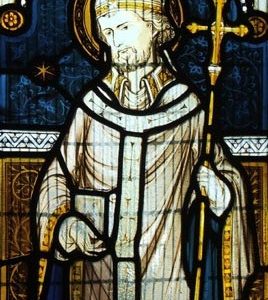Could anyone have predicted that less than a quarter of the way through the twenty-first century, many of us would be seriously questioning the ethics, practices, and philosophies of one of the most powerful segments of our society, the medical establishment? But the COVID-19 pandemic upended many of our assumptions and presuppositions. “Losing trust in doctors and the medical establishment is a sad consequence of the pandemic,” writes physician Dr. Joel S. Hirschorn. Given this significant upheaval in our dealings with the medical world, now is a good time for Catholics to remind themselves of the Catholic roots of medicine and how the Faith can help put all things medical back into a properly-ordered system. Fortunately, we have a number of guides to help us.
It is no exaggeration to say that the Catholic Church laid the foundation for modern medical infrastructure and practice. Unfortunately, the medical establishment and its partner, the insurance industry, have moved into a post-modern era where tradition is devalued and superseded in the name of efficiency. Many of the popes of the past 150 years have addressed medicine and medical care; the Catechism of the Catholic Church (CCC) touches on sickness in several locations, especially in Part Two, Chapter Two, Article Five.
For a particularly well-written book dealing with the destruction of the older model of medicine we have God’s Hotel: Doctor, a Hospital, and a Pilgrimage to the Heart of Medicine (hereafter GH) by physician and historian of medicine Victoria Sweet. In it she tells with fascinating and colorful detail of changes in a public hospital alongside her studies of St. Hildegard of Bingen and lessons from the Camino to Compostela. For insights concerning paths forward to a renewed authentically Catholic vision of health and medicine, there are the critiques of Catholic psychiatrist Dr. Aaron Kheriaty and the advice of Melody Lyons in The Sunshine Principle: A Radically Simple Guide to Natural Catholic Healing (hereafter SP), a corrective to freeform New Age health advice. To bring our story full-circle, Lyons frequently refers to St. Hildegard in her overview of Catholic medicine and health.
What makes Catholic medicine and healthcare different? Compassion. The Greeks and others had extensive knowledge of herbs and aspects of bodily health. To this compendium of knowledge Christians added a view of all human beings as made in the image and likeness of God; they also took to heart scriptural admonitions to practice charity as if to Christ Himself. Jesus taught medical principles through His incarnation and His concern for healing bodily and spiritual illnesses and afflictions. We have only to think of the Lord’s parable of the Good Samaritan and how he combined care for his neighbor with generosity and treatment of the injured man’s wounds. This concern for the poor, the traveler, and—in general—the neighbor, fueled the development of hospices, hospitals, medicine, and religious orders devoted to care for the sick. There are also many examples of Catholic saints who were healers and tended to the sick: St. Luke, Ss. Cosmas and Damian, St. Pantaleon, St. Damien of Molokai, St. Marianne Cope, and St. Gianna Beretta Molla. Although physician care and nursing is now done primarily by secular laity, there are still religious orders today specifically dedicated to the sick such as the Dominicans of Hawthorne and the Little Workers of the Sacred Hearts, the latter made well-known recently by surgeon Sister Deirdre Byrne.
In looking at western medical history, many in the medical field—Catholic or not—consider St. Hildegard of Bingen to embody medical wisdom as known in the Middle Ages. The polymath nun’s book on medicine “surprised” Victoria Sweet: “Before the reductive modern medicine I’d learned in medical school, there had been a different medical system in the West….It’s approach, I realized as I studied Hildegard’s medicine, was not mechanistic: The body was not imagined as a machine nor disease as a mechanical breakdown” (GH, 5). Learning about Hildegard helped Sweet try to recover aspects of medicine such as observation, relationship, and even thinking about diagnoses in conjunction with explanatory methods like the four ancient elements of air, water, fire, and earth. It shouldn’t surprise anyone that an emphasis on herbs and elements would beckon New Age practitioners, some of whom have tried to appropriate Hildegard for decidedly un-Catholic purposes. The key to properly situating Hildegard within the Faith is obedience, writes Melody Lyons: “[New Agers] miss the point that connecting and yielding to God’s order ultimately brings the greatest freedom. [Hildegard] was a spirited, bold, prolific, artistic, preaching polymath, and yet still submissive to the laws of Christ, the teachings of the Church, and the Rule of Saint Benedict” (SP, 4).
Pope Benedict XVI recognized St. Hildegard’s qualities in his Apostolic Letter Proclaiming Saint Hildegard of Bingen, professed nun of the Order of Saint Benedict, a Doctor of the Universal Church: “Human beings are seen as a unity of body and soul. The German mystic shows a positive appreciation of corporeity and providential value is given even to the body’s weaknesses. The body is not a weight from which to be delivered. Although human beings are weak and frail, this “teaches” them a sense of creatureliness and humility, protecting them from pride and arrogance.” Such a view is far, far away from the hedonistic and fear-driven world of materialistic medicine ascendant in the twenty-first century. It is also a bulwark against the growing threat of transhumanism. Fulfilling their role as teacher and shepherd, Popes have spoken about the proper moral approach to medicine, sickness, and health. In his 1952 address, “The Moral Limits Of Medical Research And Treatment,” Pius XII noted that, while it is doctors who decide about medical procedures, they do so in collaboration with the patient, who is a moral being in his own right. The Church and civil government also have roles to play. In 1954 the same pope commented on ethical considerations in medical practice and warned the assembled doctors that “the demands of natural morality, which forbid us to consider and treat the body of a human being merely as a thing, or as that of an animal, must at all times be dutifully respected.” Three decades closer to our time, John Paul II in the apostolic letter Salvifici Doloris wrote: “Human suffering evokes compassion; it also evokes respect, and in its own way it intimidates. For in suffering is contained the greatness of a specific mystery.” He expounds on this theme further in the same document, pointing out medicine’s limits: “Medicine, as the science and also the art of healing, discovers in the vast field of human sufferings the best known area, the one identified with greater precision and relatively more counterbalanced by the methods of ‘reaction’ (that is, the methods of therapy). Nonetheless, this is only one area. The field of human suffering is much wider, more varied, and multi-dimensional. Man suffers in different ways, ways not always considered by medicine, not even in its most advanced specializations. Suffering is something which is still wider than sickness, more complex and at the same time still more deeply rooted in humanity itself.” Contrast this to the widespread (though anecdotal) belief that doctors see themselves in “godlike” terms. Medicine as known by Hildegard and others throughout tradition firmly rejected any self-aggrandizement, instead giving God the credit for healing and medical knowledge.
As a final example along these lines, consider an October 2022 letter in the Wall Street Journal from a Catholic M.D. regarding contraception. The doctor writes that “In my 43 years as a family physician, I found that Catholic moral teaching helped me and my patients, including non-Catholics, lead happier lives.” That approach would seem at odds with a medicine that treats patients as “platforms” on which different treatments or replacement parts can be loaded, not to mention an algorithm-driven practice of inputting data and breaking down exams into proper codes and time chunks.
Before considering the trends and causes of the destruction of traditional Catholic medicine, it is instructive to briefly focus on how throughout the past 2000 years Catholicism has responded to one of the most fearsome of scourges—plague, as well as epidemics and insidious diseases such as leprosy. Even in the first century, society noticed that Christians cared for the victims of plague. Certainly not every Catholic rushed to help plague victims, but many canonized saints and others did. St. Roch recovered from plague and is often invoked against disease. St. Charles Borromeo ministered to people in sixteenth century Italy and his (un-canonized) cousin Federico supplied moving depictions of faith during plague in Alessandro Manzoni’s classic The Betrothed. St. Aloysius Gonzaga died from helping during an epidemic. St. Damien of Molokai was infected with and died from leprosy while ministering to lepers. And in the twentieth century, Blessed Pier Giorgio Frassati most likely contracted polio from his work with the sick.
How did both traditional and Catholic medicine go astray? By losing sight of the compassionate and faith-filled approach to patients—made by God—and instead embracing systems, efficiency, technology, pharmaceuticals, and government intrusion. As the CCC (2288) puts it: “Life and physical health are precious gifts entrusted to us by God. We must take reasonable care of them, taking into account the needs of others and the common good. Concern for the health of its citizens requires that society help in the attainment of living-conditions that allow them to grow and reach maturity: food and clothing, housing, health care, basic education, employment, and social assistance.” Sweet sums up the final change in her hospital as it moved from an older, still recognizably rooted in the Medieval model to a 21st Century paradigm: “In the new Laguna Honda, the old-fashioned ‘medical model’ of physicians would be replaced by a ‘social model’—whatever that was—and ‘health-care workers,’ nurses, social workers, and psychologists not physicians, would take care of ‘clients’” (GH, 325). It should be noted that Laguna Honda cared for many homeless and mentally-ill patients, but the changes reflect trends throughout medical systems, especially in the U.S.
Additional factors include the effect of medical insurance on all healthcare in terms of cost, focus, scheduling and bureaucracy. Because Catholic hospitals are so prevalent in the U.S., many places are dominated by them. This, plus an erosion of the Faith in recent decades, means that sometimes both the public and staff forget the avowed Catholic mission of the hospitals. The application of outside pressure from government—especially the federal government—has further challenged and diluted the Catholicism of Catholic medicine and healthcare.
The onset of the COVID-19 pandemic revealed significant weaknesses in both modern healthcare and Catholic medicine, as well as society and Catholicism in general. Fear of infection separated family members from one another and doctors from patients. Debates raged about proper treatments and protection against the disease. Nurses and others were fired for refusing an experimental and novel vaccine. Debates about science were subsumed by politics. Medical ethicists and moral theologians groped for approaches to a divisive disease. Worst of all from a Catholic perspective, bishops around the world closed parishes out of fear of infection and/or imposed harsh and inflexible conditions on the dispensing of the Eucharist. Some times priests were even denied access to dying patients in hospitals and nursing homes. “Predictably, this has left devout Catholics adrift,” writes Auguste Meyrat.
There are many ways medicine can be reformed, but doctors, other providers, nurses, and administrators first need to realize they have lost the trust many people had in them pre-pandemic. Melody Lyons’ suggestions in The Sunshine Principle are a good place to start because they emphasize personal responsibility for health and working to prevent disease and deterioration rather than relying exclusively on medical and chemical interventions after a breakdown in one’s body. Lyons emphasizes nutrition and exercise, but also the spiritual aspects of health which secular medicine often overlooks. In this she is pointing us to the best aspects of pre-modern medicine and a Christ-centered view of humans as body and soul. It does not reject modern medicine, but acknowledges that oftentimes by the time we go to the doctor problems have already gone too far. “Ask any physician, and you’ll find that the majority of medical school is spent learning to diagnose disease, not to prevent it,” she writes (SP, 18).
Isn’t it time Catholics demanded more Catholicism from their health care, especially from Catholic hospitals? There has long been a debate about the separation of Church and state, but must we give in to the separation of Faith and medicine? It’s past time for a robust debate on how to improve medicine, and to return medicine to its Catholic roots of accurate knowledge, compassion, and focus on God’s mission for us in a fallen world.
✠
Photo by Ian Hutchinson on Unsplash


